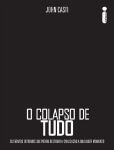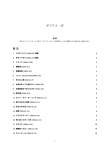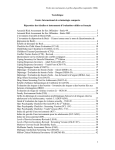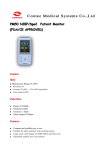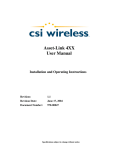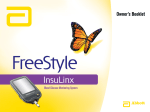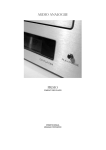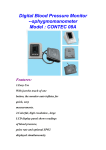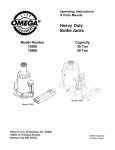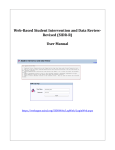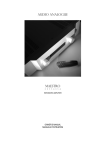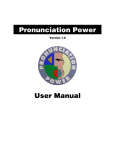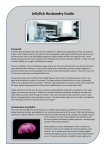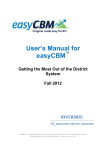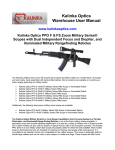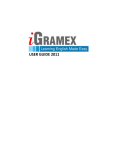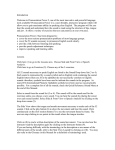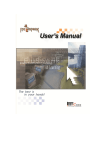Download Reading Curriculum-Based Measurement Administration
Transcript
Reading Curriculum-Based Measurement Administration and Scoring Guide Pearson Executive Office 560 Green Valley Drive Bloomington, MN 55437 800.627.727 www.PsychCorp.com Copyright © 202 NCS Pearson, Inc. All rights reserved. Warning: No part of this publication may be reproduced or transmitted in any form or by any means, electronic or mechanical, including photocopy, recording, or any information storage and retrieval system without permission in writing from the copyright owner. Pearson, aimsweb, and the aimsweb logo are trademarks in the U.S. and/or other countries of Pearson Education, Inc., or its affiliate(s). Produced in the United States of America. 2 3 4 5 6 7 8 9 0 2 A B C D E Contents Overview 1 Introduction 1 Administering and Scoring R–CBM 2 Choosing R–CBM Probes 2 Paper or Computer-Assisted Administration 2 Recording the Student’s Performance 2 Materials You Will Need 3 Paper Administration 3 Computer-Assisted Administration 3 General Administration Procedures 4 Considerations 4 Testing Students With Special Accommodations 5 Screening With R–CBM 5 Progress Monitoring With R–CBM 5 R–CBM Administration Directions 6 R–CBM Scoring Directions 7 During Administration 7 Definition of Correct Words and Errors 7 Using the Examiner’s Copy (Paper Administration) 10 Entering Scores in the aimsweb System 10 Assessing the Qualitative Features of Reading as Part of R–CBM 11 Qualitative Features Checklist 12 Figures Figure Example of an Examiner’s Copy Marked with Common Errors For more information visit aimsweb.com — 866.313.6194 iii 9 R–CBM Administration and Scoring Guide Copyright © 2012 Pearson Education, Inc., or its affiliate(s). All rights reserved. Overview Grades –2 (Use Grade 8 forms for Grades 9–2) Administration Individual Paper presentation of reading passage Paper or computer-assisted recording of errors Working time 3 minutes (Screening) minute (Progress Monitoring) Scoring On paper: Use the Examiner’s Copy to hand score and calculate total scores. Online: Record errors on screen (automatic scoring) Introduction Reading Curriculum-Based Measurement (R–CBM) is a brief, individually administered, standardized test of oral reading for grades (winter) through 2. There are 23 test forms (probes) at Grade and 33 grade-level forms for each grade from 2 through 8. The national norms extend to Grade 2, based on the Grade 8 forms. R–CBM is designed to be used in the universal screening of all students at the beginning, middle, and end of the school year. The probes also are to be used for frequent progress monitoring of students identified as at risk and for survey-level (off-level) assessment, as explained in the Introduction to aimsweb (available on the aimsweb site). You must follow all directions carefully to be able to use the normative (national, district, or school) data accurately in making decisions or drawing conclusions about a student’s performance. Altering the instructions to students, the presentation of the probes, the time allowed for each probe, or using probes as teaching instruments invalidates any decisions made or conclusions reached about student performance. It is important that you (the examiner) become familiar with these administration directions before administering an R–CBM probe. For more information visit aimsweb.com — 866.313.6194 1 R–CBM Administration and Scoring Guide Copyright © 2012 Pearson Education, Inc., or its affiliate(s). All rights reserved. Administering and Scoring R–CBM Choosing R–CBM Probes For universal screening (benchmark testing), use the designated set of probes (, 2, and 3) for the student’s grade. Use the same set of probes for each screening period (fall, winter, and spring). For progress monitoring, administer a single probe rather than the set of three, and use a different R–CBM probe each time. The probes (probes 4–23 at grade and 4–33 at grades 2–8) are equivalent and you can give them in any order, as long as you use a different R–CBM probe at each assessment of a particular student. There are two ways to do this. .In aimsweb version .0, the Progress Monitor probe numbers are listed in random order on the Score Entry screen. You may choose different probe numbers from the dropdown menu. In aimsweb version 2.0, the Assess screen displays the probes that have not been administered to the student, as well as the probes the student has completed. OR 2. You may administer probes in numerical order. Use the method that fits your workflow and ensures that you do not inadvertently give a student the same probe twice. You can use R–CBM probes in survey-level assessment (SLA) and for off-grade testing with students who are struggling readers. (If you have a student who you think may be struggling, use the Qualitative Features Checklist at the back of this manual to further assess the student’s skill level.) For information on SLA and off-grade testing, please refer to guidelines in the Introduction to aimsweb. For more examples, refer to Progress Monitoring Strategies for Writing Individualized Goals in General Curriculum and More Frequent Formative Evaluation (2002), by Mark Shinn. Paper or Computer-Assisted Administration For each administration of an R–CBM probe, the student reads a passage from a printed page. In aimsweb version .0, the aimsweb Manager at your school will download a master copy of the probe and Examiner’s Copy from the Benchmark and Progress Monitor tabs or the Download tab of the aimsweb site, and you may photocopy these as needed. In aimsweb version 2.0, go to the Assess screen and click the Downloads tab. Please keep the probes and Examiner’s Copies in a secure place before and after using them. Recording the Student’s Performance oo For paper administration—use the paper Examiner’s Copy oo For computer administration—click or touch the computer monitor screen or tablet screen. The computer or device times the administration and calculates the scores. For more information visit aimsweb.com — 866.313.6194 2 R–CBM Administration and Scoring Guide Copyright © 2012 Pearson Education, Inc., or its affiliate(s). All rights reserved. Materials You Will Need Paper Administration You will need a printed copy of the oo R–CBM Administration Directions, oo probe(s) to be read by the student (this copy is reusable), and oo corresponding Examiner’s Copy(s) for you to score. (The Examiner’s Copy has a number at the end of each line, indicating the cumulative number of words.) You will also need oo a timer, clock, or watch that shows seconds; oo a pencil or pen for scoring; and oo a clipboard or other device so that you can record performance without the student seeing your Examiner’s Copy. You also may want to use a voice recorder so that you can refer to it when reviewing how you scored the student’s performance or for qualitative analysis. Computer-Assisted Administration You will need oo a computer or tablet that is connected to the Internet; oo a printed copy of the R–CBM probe(s) to be read by the student (this copy is reusable); and oo a voice recorder (optional). For more information visit aimsweb.com — 866.313.6194 3 R–CBM Administration and Scoring Guide Copyright © 2012 Pearson Education, Inc., or its affiliate(s). All rights reserved. General Administration Procedures Have the student read the passage aloud for minute. Record any errors—words that are mispronounced, substituted, omitted, or read out of sequence, that the student does not self-correct within 3 seconds. See the Definition of Correct Words and Errors section for details on how to identify errors. Before beginning the administration, make sure your testing area is reasonably quiet and away from distractions. Sit across from the student, not beside the student. For paper-pencil administration, make sure you have recorded the student’s name and the date on the your Examiner’s Copy. Considerations oo Emphasize Words Read Correctly (WRC). Because R–CBM is rich in information, you may want to count or record everything the student does. However, do not lose sight of the goal of obtaining an accurate count of the number of words read correctly. oo 3-Second Rule. If a student stops or struggles with a word for 3 seconds, tell the student the word and mark it as incorrect. You want enough time to observe if the student is using a strategy for unfamiliar words, but not so long that the student gets frustrated or gives up. oo No Other Corrections. R–CBM is about testing, not teaching. Do not correct the student when he or she makes an error. Minimize “examiner talk” to maximize student reading. oo Discontinue Rule. During screening only, if the passage is so hard that the student reads fewer than 0 words correctly in minute, do not administer any other passages; use the score from the passage(s) already administered. oo Be Polite. Although you need to mark where the student reached at the end of minute, it is polite to let the student finish the sentence before saying Stop. However, do not let them finish the story. oo Determining Screening Score When a Median Score Cannot be Obtained. If screening results in fewer than three scores, rendering no median score (due to the Discontinue Rule or a spoiled administration), you have two options: . If the student completed two administrations, use the average of the words read correctly and the average of the number of errors to determine the total words read score. 2. If the student completed only one administration, report the scores from that administration. When you enter information in the system, use a dash to indicate the missing data. DO NOT enter zeros to indicate missing data. oo Speed Reading. You may encounter a student who views R–CBM as a “speed reading” test. If a student is reading very quickly with a high level of accuracy, let the student continue. However, if the student is making many errors because she or he is trying to read very quickly, interrupt the student and say: This is not a speed reading test. Begin again, and be sure to do your best reading. Reset the timer and begin again. For more information visit aimsweb.com — 866.313.6194 4 R–CBM Administration and Scoring Guide Copyright © 2012 Pearson Education, Inc., or its affiliate(s). All rights reserved. oo Interruptions. If something disrupts testing (bells, dropped passages, timing), discard the passage and administer another. In this case, you may substitute a progress monitoring passage for a screening passage. Testing Students With Special Accommodations The general principles governing the use of accommodations in aimsweb administration for students with disabilities are described in the Introduction to aimsweb. Whenever normative interpretations will be made (typically, in universal screening), it is important to adhere to the specific R–CBM guidelines described below so that interpretations will be accurate. A wider range of accommodations may be used in progress monitoring, as long as they are applied consistently across the monitoring period. Like any other test, R–CBM may be inappropriate for some students. For students with certain speech impairments (e.g., moderate to severe stuttering disorder), students who are hearing impaired and exclusively use sign language, or students with disabilities that interfere with perceiving the text (e.g., uncorrected vision impairment that is not adequately accommodated by enlarged text), R–CBM may not be a valid measure of reading. Screening With R–CBM The following accommodations are allowed for R–CBM administration during screening (benchmarking): oo enlarging the test form (probe), oo repeating the spoken directions when introducing R–CBM, and oo modifying the environment (e.g., special lighting). The following are not allowed as accommodations during screening: oo extending the administration time, oo providing feedback during administration beyond what is specified, oo providing practice administrations, and oo students pre-reading the passages. Progress Monitoring With R–CBM In addition to the accommodations allowed for screening, other appropriate accommodations (including extending the administration time) may be made during R–CBM progress monitoring as long as oo the accommodations are applied consistently for the student throughout the progress monitoring period, and oo normative interpretations are not made. Document any accommodations made for the student. For more information visit aimsweb.com — 866.313.6194 5 R–CBM Administration and Scoring Guide Copyright © 2012 Pearson Education, Inc., or its affiliate(s). All rights reserved. R– CB M Admin istration Direction s A dmi n is t ra t io n Place the unnumbered copy of the R–CBM probe in front of the student. Place the Examiner’s Copy or computer/device screen in front of you, shielded from the student’s view. Say to the student: When I say “Begin,” start reading aloud at the top of this page. Read across the page (demonstrate by pointing across page). Try to read each word. If you come to a word you don’t know, I’ll tell it to you. Be sure to do your best reading. Are there any questions? D irec t io n s Answer any questions the student may have. Say: Begin. Start timing when the student says the first word. If the student does not say a word after 3 seconds, say the first word. Mark the word that you provided as incorrect. When the student says the next word, start timing. As the student reads, mark any errors (words read incorrectly, skipped, or out of order). oo Paper administration: Draw a slash ( / ) through the incorrect word. Record any insertions by writing them above the line of text where the insertion was made. If the student self-corrects within 3 seconds, mark the self-correction with “SC.” oo Computer-assisted administration: Click/touch the incorrect word. If the student self-corrects within 3 seconds, click/touch the word again to remove the mark. If the student skips a line, click the box to the left of the line. Do not correct errors. Mark them as incorrect and let the student continue reading. If a student stops or struggles with a word for 3 seconds, give the student the word, mark it as incorrect, and move on. At the end of minute, place a bracket ( ] ) (or click/touch) after the last word the student attempted. Let the student finish reading the sentence and then say; Stop. For universal screening, administer the second and third probes the same way, but shorten the directions. Say: When I say “Begin,” start reading aloud at the top of this page. You may also use these abbreviated directions in progress monitoring after the student has become familiar with the task. In universal screening, if the student reads 0 words or less correctly on the first or second probe, do not administer the remaining probe(s). For more information visit aimsweb.com — 866.313.6194 6 R–CBM Administration and Scoring Guide Copyright © 2012 Pearson Education, Inc., or its affiliate(s). All rights reserved. R–CBM Scoring Directions An R–CBM administration yields a primary score, the number of words read correctly (WRC) in minute, and a secondary score that reflects accuracy—either the number of errors or the percentage of words read correctly. In universal screening, you calculate these scores for each of the three probes, and the final reported score of each type is the median (middle) of the three values. If you administer only two probes in universal screening (because WRC on the second probe was less than 0), average the scores on the two probes administered to get the final value. With paper administration, you must manually calculate these scores using the Examiner’s Copy. To compute WRC, count the number of errors and subtract that number from the numerical value of the last word attempted. If a student skips a line in R–CBM, count all of the words in the line as errors. With computer-assisted administration, the aimsweb system automatically calculates the WRC and error/accuracy scores. During Administration Definition of Correct Words and Errors For computer-assisted administration, mark errors as the student reads the probe by clicking or touching the incorrect word. If the student self corrects, click the word again. For paper administration, draw a slash through an incorrect word and indicate any self-corrections with an “SC.” Write any inserted words above the line, approximately where inserted. Refer to the following definitions of correct responses and errors when making scoring decisions. Figure is an example of a probe marked with common errors. Correct Credit responses as correct when the student oo reads words correctly, pronounces them correctly, and reads them in the correct order; oo initially mispronounces or omits a word, but self-corrects within 3 seconds oo pronounces a word in a way that reflects a common regional pronunciation (e.g., “warsh” for “wash”); pronounces the word, but has a common speech problem such as a lisp (e.g., “tetht” for “test”); or stutters when pronouncing a word. ; Use your best judgment when scoring and apply that judgment consistently across passages. Error Record an error when the student oo mispronounces or substitutes for a word oo omits or skips words, including an entire line oo hesitates, or struggles to correctly produce a word, for more than 3 seconds oo transposes the order of two words—both count as errors For more information visit aimsweb.com — 866.313.6194 7 2 ; 3 ; 5 4 ; or . R–CBM Administration and Scoring Guide Copyright © 2012 Pearson Education, Inc., or its affiliate(s). All rights reserved. Neither Correct nor an Error Ignore the following words. They do not count as correct, nor do they count as errors. oo Repeated words oo Inserted words 6 7 Special Considerations oo The student must read numbers within a passage using standard conventions and as whole units, not as their component parts. For example, the student should read May 5, 999 as “May fifth, nineteen ninety-nine,” not as “May five, one nine nine nine.” oo In a word that contains one or more hyphens, if each piece can stand alone as a real word, then score each piece separately (e.g., “fifty-seven,” “son-in-law”). Otherwise, score the whole hyphenated word as a single word (e.g., “re-evaluate,” “Bar-b-que”) 8 . If the student reads any part incorrectly, count the whole word as a single error. oo Count an abbreviation as a word. The student must read the full word correctly to receive credit (for example, “Ave.” must be read as avenue, not “ave”). If the student does not read it correctly, count it as an error. For more information visit aimsweb.com — 866.313.6194 8 R–CBM Administration and Scoring Guide Copyright © 2012 Pearson Education, Inc., or its affiliate(s). All rights reserved. Jellyfish are creatures found in most bodies of salt water, from 2 the tropical waters of the Caribbean Sea, to the cold, dark waters of the Arctic Ocean. sc Jellyfish are unusual creatures. When seen in the water, it's hard to believe they are a species from4this planet. They look like aliens hanging suspended in water with their luminous layers of tissue and flesh. They have long, curly tentacles and plastic like bubble tops that sway in the sea. 3 13 27 40 54 67 78 5 Although it's difficult to believe, jellyfish have no heart, blood, brain, or gills. You 92 can see through their mostly hollow stomach cavities where their food is digested 105 and dissolved. Jellyfish have no proper eyes or ears. In fact, it's possible to 119 believe that jellyfish are just brainless blobs without the slightest spark of 131 intelligence. Amazingly enough, despite their lack of sight and hearing, jellyfish can distinguish touch, temperature, light, and darkness. They also know the 142 153 direction and pull of water currents. 159 Jellyfish come in an assortment of colors and shades. The jellyfish living6in cooler waters are generally pale or milky white in color. Many of the jellyfish that sc live in warmer, tropical waters are often strikingly colored in shades of magenta, scarlet, yellow, and orange. sometimes 7 A jellyfish can be as tiny as a thimble, and some can grow to be as colossal as sc a satellite dish. Most jellyfish can maneuver feebly in the water; however, their poor swimming skills place them at the mercy and whimsy of ocean currents. Some jellyfish ride the ocean currents alone, while other species travel in 8 special groups called colonies. The man-of-war is an example of a highly adapted jellyfish that travels with a colony. The man-of-war serves a special function in its colony. It catches prey with a very long tentacle that can trail as far as one hundred feet through the sea. The man-of-war's prey includes shrimp, squid, and fish. It also produces potent venom that is harmful to humans who may swim nearby, unaware of the man-of-war's clever and stunning snares. 172 187 200 204 222 235 248 260 275 291 308 323 336 346 Figure Example of an Examiner’s Copy Marked with Common Errors . Student initially said “topical,” but self-corrected to “tropical” within 3 seconds. Scored as correct. 2. Student substituted “Antarctic” for “Arctic.” Scored as incorrect. 3. Student skipped entire line. Each word counted as incorrect. 4. Student hesitated 3 seconds and the examiner provided the word “luminous.” Scored as incorrect. Jellyfish are creatures Copyrare ight ©scored 2001 by Nas CS P earson, Inc. 5. Student transposed the words “blood” and “brain.” Both words incorrect. Grade 8, Passage 2 All Rights Reserved. 6. Student repeated the word “jellyfish.” This did not affect the score. 7. Student inserted the word “sometimes” between “can” and “grow.” This did not affect the score. 8. Student said “a” instead of “of” in “man-of-war.” “Man-of-war” is worth 3 points because each word of the hyphenate can stand on its on; therefore, one word is scored as incorrect in the sequence of three words. For more information visit aimsweb.com — 866.313.6194 9 R–CBM Administration and Scoring Guide Copyright © 2012 Pearson Education, Inc., or its affiliate(s). All rights reserved. Using the Examiner’s Copy (Paper Administration) Write the student’s name on the Examiner’s Copy. The Examiner’s Copy is the same as the probe the student reads, except for the cumulative word count shown at the end of each line. This makes it easier to identify the number of the last word the student attempted. oo Write the number of the last word attempted on the Examiner’s Copy. oo Count the number of errors and write that number below the last word attempted. oo Subtract the number of errors from the number of the last word attempted to obtain the words read correctly (WRC). To obtain the accuracy percentage, divide WRC by the number of the last word attempted, and round to two decimal places. Entering Scores in the aimsweb System If you used computer-assisted administration, the R–CBM scores are automatically stored in the aimsweb system. With paper administration, you must enter the scores into the system. For information on this procedure, refer to Appendix A of the aimsweb Software Guide. For more information visit aimsweb.com — 866.313.6194 10 R–CBM Administration and Scoring Guide Copyright © 2012 Pearson Education, Inc., or its affiliate(s). All rights reserved. Assessing the Qualitative Features of Reading as Part of R–CBM The following Qualitative Features Checklist is a convenient way to structure your observations. It includes the skills commonly displayed by good readers and lacking in struggling readers. After you have listened to students read from three R–CBM passages (usually, though not necessarily, the three screening passages for the student’s grade), you can complete the Qualitative Features Checklist. Listening to the student read three passages gives you a better opportunity to observe the student’s oral reading skills before you complete the Qualitative Features Checklist. aimsweb Version .0 In version .0, you can select the Qualitative Features Checklist as part of the student’s Benchmark Improvement Report in the My Classes tab (Teachers) and the Scoring tab (Managers). You may also print a copy of the Qualitative Features Checklist in this manual. aimsweb Version 2.0 Version 2.0 does not present the Qualitative Features Checklist onscreen. However, you may photocopy it from this Guide and use it to record your observations. Version 2.0 also includes an open notes field for R–CBM in which you can enter qualitative information about a student’s performance. For more information visit aimsweb.com — 866.313.6194 11 R–CBM Administration and Scoring Guide Copyright © 2012 Pearson Education, Inc., or its affiliate(s). All rights reserved. Qualitative Features Checklist Student Name: Examiner: Date: After you have listened to the student read connected text, indicate the percentage of the time you observed these important features of successful reading. (Note that you may not observe all these features during each observation.) Reads fluently or efficiently. Reads very accurately (> 95%). Has an effective strategy for unknown words. Reading errors preserve rather than distort meaning. Reads with expression (attention to prosodic features). Self-corrects errors (comprehension self-monitoring). Adjusts pace when complexity or “considerateness” of text changes. Additional Comments: For more information visit aimsweb.com — 866.313.6194 12 R–CBM Administration and Scoring Guide Copyright © 2012 Pearson Education, Inc., or its affiliate(s). All rights reserved.















